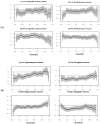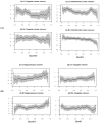Effects of Parental Internalizing and Externalizing Behavior Problems on Children's Limbic Brain Structures-An MRI Study
- PMID: 36291253
- PMCID: PMC9599765
- DOI: 10.3390/brainsci12101319
Effects of Parental Internalizing and Externalizing Behavior Problems on Children's Limbic Brain Structures-An MRI Study
Abstract
Parental behavior problems have long-term effects on children's limbic brain structures and functions. Parental behavior problems-related brain changes in children may lead to mental disorders and behavior dysfunction later in life. However, our understanding of the relationship between parental behavior and children's brain structures is less obvious when children and adolescents are studied in a general population without mental disorders. The majority of studies on the relationship between parental behavior and adolescent brain structure have been focused on severe forms of the following parental behavior problems: (1) internalizing behavior associated with mood and anxiety disorders, and (2) externalizing behavior associated with substance use and violence. A few studies examined the effect of normative variations or subtle differences in parental behavior. Therefore, we utilized a large study-Adolescent Brain Cognitive Development (ABCD)-to determine relationships between normative variation in parental internalizing and externalizing behavior and limbic brain structures in children and adolescents without mental disorders. Quantile (median) regression models were used to compute associations between parental behavior and children's limbic structures. We found that parental internalizing and externalizing behaviors are uniquely associated with children's limbic structures after adjustment for biological confounders and parental socioeconomic status. Our findings indicate that normative parental behavior may have a significant early influence on limbic structures of normally developing children and adolescents. Accelerated or delayed limbic structure maturation may account for children's and adolescents' behavioral inadequacies and a risk of developing specific mood disorders or substance abuse problems later in life.
Keywords: behavioral measures; brain imaging; child development; parenting; quantile regression.
Conflict of interest statement
We declare no conflict of interest.
Figures



Similar articles
-
Parental worry, family-based disaster education and children's internalizing and externalizing problems during the COVID-19 pandemic.Psychol Trauma. 2021 May;13(4):486-495. doi: 10.1037/tra0000932. Epub 2021 Jan 21. Psychol Trauma. 2021. PMID: 33475409
-
Brain structure and internalizing and externalizing behavior in typically developing children and adolescents.Brain Struct Funct. 2020 May;225(4):1369-1378. doi: 10.1007/s00429-019-01973-y. Epub 2019 Nov 7. Brain Struct Funct. 2020. PMID: 31701264
-
Associations among Early Exposure to Neighborhood Disorder, Fathers' Early Involvement, and Children's Internalizing and Externalizing Problems.J Evid Based Soc Work (2019). 2020 Sep-Oct;17(5):558-575. doi: 10.1080/26408066.2020.1782302. Epub 2020 Jun 26. J Evid Based Soc Work (2019). 2020. PMID: 32589105
-
The Association between Coparenting Behavior and Internalizing/Externalizing Problems of Children and Adolescents: A Meta-Analysis.Int J Environ Res Public Health. 2022 Aug 19;19(16):10346. doi: 10.3390/ijerph191610346. Int J Environ Res Public Health. 2022. PMID: 36011980 Free PMC article. Review.
-
Parental Phubbing and Child Social-Emotional Adjustment: A Meta-Analysis of Studies Conducted in China.Psychol Res Behav Manag. 2023 Oct 19;16:4267-4285. doi: 10.2147/PRBM.S417718. eCollection 2023. Psychol Res Behav Manag. 2023. PMID: 37877136 Free PMC article. Review.
Cited by
-
The conscious processing of emotion in depression disorder: a meta-analysis of neuroimaging studies.Front Psychiatry. 2023 Jun 28;14:1099426. doi: 10.3389/fpsyt.2023.1099426. eCollection 2023. Front Psychiatry. 2023. PMID: 37448490 Free PMC article.
-
Effects of parental mental health and family environment on impulsivity in preadolescents: a longitudinal ABCD study®.Front Behav Neurosci. 2023 Oct 24;17:1213894. doi: 10.3389/fnbeh.2023.1213894. eCollection 2023. Front Behav Neurosci. 2023. PMID: 37942273 Free PMC article.
-
Associations between parental psychopathology and youth functional emotion regulation brain networks.Dev Cogn Neurosci. 2024 Dec;70:101476. doi: 10.1016/j.dcn.2024.101476. Epub 2024 Nov 12. Dev Cogn Neurosci. 2024. PMID: 39541797 Free PMC article.
-
Shared genetics and causal relationship between sociability and the brain's default mode network.Psychol Med. 2025 May 22;55:e157. doi: 10.1017/S0033291725000832. Psychol Med. 2025. PMID: 40400235 Free PMC article.
References
-
- Kessler R.C., McLaughlin K.A., Green J.G., Gruber M.J., Sampson N.A., Zaslavsky A.M., Aguilar-Gaxiola S., Al-Hamzawi A.O., Alonso J., Angermeyer M., et al. Childhood adversities and adult psychopathology in the WHO World Mental Health Surveys. Br. J. Psychiatry. 2010;197:378–385. doi: 10.1192/bjp.bp.110.080499. - DOI - PMC - PubMed
LinkOut - more resources
Full Text Sources

